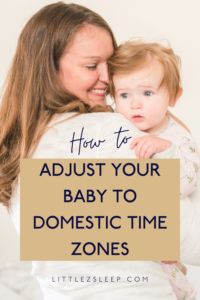How to Adjust Your Baby to Domestic Time Zones
Are you traveling with your baby soon and wondering how to adjust their sleep schedule to a new domestic time zone?
If you have an upcoming trip that inevitably crosses over domestic time zones, this is for you! Don’t let time change stop you from traveling with your family! I’m giving you a plan for how to adjust your baby to domestic time zones so you can enjoy your vacation and go anywhere. I’m covering this topic on the podcast as well! Click here to listen in!
Before we jump in, if you want to travel confidently as a family and keep sleep a thing wherever you go, you need the Little Z’s Travel Guide! If you’re worried about how to make naps on the go work, packing seems daunting, you don’t know how to entertain your child on the airplane or on a long road trip… I’ve got you!! This is not your average Travel Guide. We give you tips on everything, including how to take a good beach nap! From babies to preschoolers, The Travel Guide is ready for you and it’s only $25 – click here to grab yours today!
Now, my family just got back from a trip to New Mexico!
Any time as a kid when I told people I was going to New Mexico as a vacation, everyone was like “Mexico!?” No… NEW Mexico!
Every summer we traveled from Richmond, VA, to Albuquerque, NM with all my cousins to see my grandparents. We were just able to take the girls for their second trip and it was SO fun.
Every time that we make these changes, and our girls have done a lot of travel in their lives, time zone travel is tricky!
From my own experience, but also as a pediatric sleep consultant, I want to teach you how to guide your family through these time changes.
IF YOU’RE ONLY 1 HOUR AHEAD OR BEHIND
If you’re only 1 hour ahead or 1 hour behind, you can easily stay in your time zone and pretend you never left.
If you’ll be there for 2-3 weeks or more, yes you may want to jump into the time zone.
However, if it’s just for a few nights, there’s no problem with keeping your same schedule!
Let’s say you’re traveling from Eastern to Central Time Zone, keep your normal schedule from home. So they go to bed at 7pm at home? Put them down at 6pm here!
The pro here is that you can put your baby down early and hang out the rest of the evening. The con is that there’s always a chance this backfires and your baby protests to stay up knowing everyone else is or starts waking up earlier and earlier.
MORE THAN 1 TIME ZONE AWAY
You cannot keep your old schedule! You’ll be so stressed out and so confused. Trust me on this.
Instantly jump into whatever time it is as soon as you arrive!
It gets tricky on your 1st day because you’re probably tired. There’s grace in this first day, but you’re going to jump into your new time zone.
TIPS FOR THE FIRST DAY
1. Get sunlight exposure! Go outside as soon as you can. Our bodies do so well when we can absorb whatever sunlight is available. This has to do with sleep because our melatonin levels (the sleepy hormone secreted from inside your brain!) are regulated by the sun.
As the sun goes down, that’s the cue for melatonin to be produced and then overnight melatonin continues to be secreted and you can stay asleep all night. Don’t cue melatonin via turning the lights down or staying inside.
2. Commit to the new meal times. You may be so tired and ready for bed, but if you skip dinner, it’ll mess with your body clock again.
So if you get there and are tempted to go to bed without dinner because you’re just so tired, but it’s a normal dinner hour there, eat the dinner!! You’re going to get messed up if you skip it.
3. Commit to the normal bedtime. I always forget that the first day or so of travel (even for my children who are now 7 and 8 years old), is difficult! It’s not super easy, but it’s worthwhile. We always have snappier attitudes and more meltdowns the first 48 hours.
So on the very first night, commit to their normal bedtime. However, you know your child best. An example from when we recently traveled… We were up super early on our flight and they were exhausted. So we actually put our girls down 1 hour earlier on the first night. I wasn’t going to push them to stay up till what felt like 10:30pm to their bodies!
Try to make it within at least an hour within their normal bedtime and put them to bed when they really, really need it. This is when getting outside will help!
So if your toddler is melting down at 4:30pm because their body clock thinks it’s still 6:30pm like at home when it’s typically the start of bedtime, then get outside, distract them for an hour, and start bedtime at 5:30pm so they only are up an hour later.
Listen, I know that if you’re reading this, your child sleeps well! If you had a horrific sleeper, you wouldn’t be willingly traveling all over the world. If you’ve committed to making sleep a thing through one of our sleep courses, you CAN travel! You can go places.
It’s not going to be perfect, they’re going to get cranky, it’ll take some time to adjust, but these 3 tips will help you adjust quicker and more smoothly to your new time zone!
DAYTIME SLEEP:
For daytime naps, when you’re adjusting to the new time zone, you will jump into the new time zone for naps.
There will be a period of adjustment. Your baby or toddler may protest the nap a little bit, especially if they’re overtired. You may also need to bend your sleep rules to help them adjust to their new sleep environment.
Create a good nap environment. Is there sunlight coming into their room? Whether you want to use black trash bags or foil for the windows, or if you want to use the SlumberPod, make sure the room is dark.
Remember at the end of the day, if sleep has been difficult, that’s okay! Traveling and extra fun takes a lot out of you. When you’re traveling domestically, my biggest suggestion is to jump into the new time zone and give everyone grace for at least 24-48 hours.
LOVE THIS? PIN IT FOR LATER!





